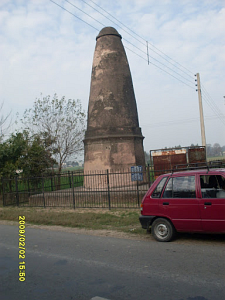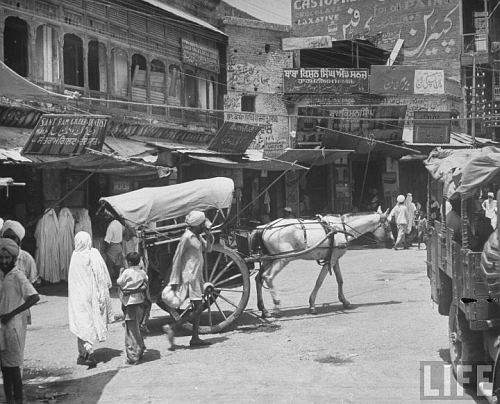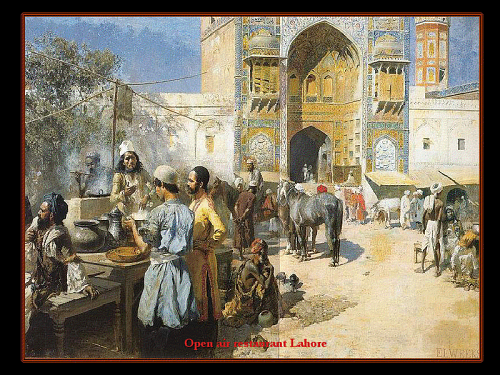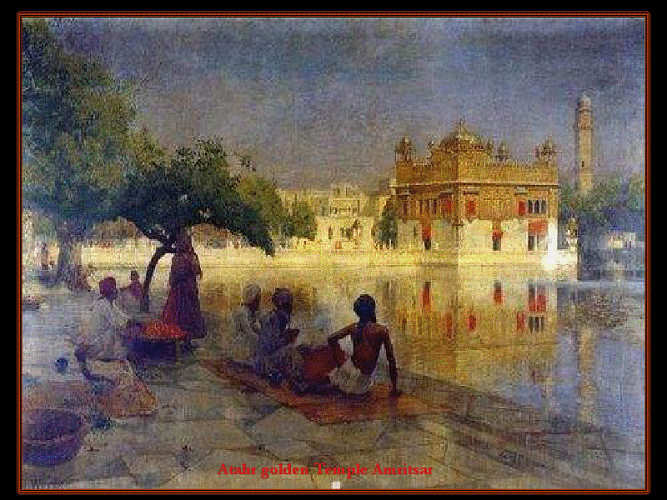BOTH AMRITSAR AND JALANDHAR WERE NOT ON THE ORIGINAL SHER SHAH SURI HIGHWAY

Harjap Singh Aujla
Since times immemorial India was famous amongst its North Western neighbors as a land of plenty and opportunity. From the Aryans of Central Asia to Alexander the Great of Macedonia and the Islamic invaders from the Western and Central Asian countries, India has been a land of fascination for every invader. Some of them were interested only in plundering the wealth of its state and citizens and some decided to adopt this four season fertile land as their future dream home. Most of the invaders crossed into India through the Khyber Pass in Pakhtoonkhwa area with the aim of capturing or looting the affluent capital of this country and other wealthy towns and cities. Peshawar and Lahore were the other important landmark cities on the way to the national capital, which most of the time used to be Delhi, Agra or Patliputra (Patna).

Old milestone in village Jehangir in Jalandhar district
Although need based animal driven carriage paths were built all over the country from time to time, yet Sher Shah Suri was the first visionary Emperor of India to realize that the most fertile North Western heartlands of the country deserved a decent all weather thoroughfare. So he applied the best available technology to improvise a stabilized clay road with good drainage for monsoon runoff to link Agra Delhi with Peshawar. Another branch linked Lahore to Multan also. The route from the national capital of Delhi to the provincial capital of Lahore was roughly via Panipat, Ambala, Shambhu, Sarhind, Doraha, Ludhiana, Phillaur, Noormahal, Nakodar, Jehangir, Sultanpur Lodhi, Goindwal, Jalalabad and Serai Amanat Khan. When Sher Shah Suri built this highway, Amritsar did not exist as a city, it was only a small group of villages. Jalandhar did exist as a small town, but Nakodar and Noormahal (under a different name Kot Kahlur) were politically and culturally more important places to the Islamic rulers. Sultanpur Lodhi was a very prominent garrison headquarter, where the Lodhi Dynasty, which ruled Northern India prior to the establishment of Mughal Empire, had its permanently stationed Subedar assisted by a contingent of army. Later on the Mughals occupied Sultanpur Lodhi too. From Sultanpur Lodhi the Sher Shah Suri Highway crossed the Beas at Goindwal and entered village Jalalabad and the alignment passed through Serai Amanat Khan (known with a different name then) before entering the city of Lahore some twenty five miles to the West. Later on during the reign of Mughal Emperor Jehangir, three magnificent Serais (inns) were built in Noormahal, Jehangir, and Serai Amanat Khan. All three inns were located along the original Sher Shah Suri Highway and now form a part of Jalandhar and Amritsar districts.

Sikhs in pre-1947 Lahore
When the British Colonial Rules decided to rebuild the Grand Trunk Road in the beginning of the nineteenth century, they roughly followed the same alignment which was adopted by Sher Shah Suri. They built a compacted earth and gravel road on the pattern of the European highways of the time. These highways were good enough to handle two way passages of horse drawn carriages. But in India of those days, the primary means of transportation was bullock carts, which were slower in speed and less taxing on the compacted earth surfaces. But the British possessions, under a treaty with the Sikh Kingdom of Lahore, did not cross the Sutlej, so they terminated the road at Ludhiana and built another similar road to link Ludhiana with Ferozepore, from where they managed the Anglo-Sikh Battles to annexe the Sikh Empire.

ANCIENT OUTDOOR EATRY IN LAHORE
During the period of the Sikh Empire, the most heavily travelled highway was between Lahore and Amritsar via Mughalpura, Wagha, Pul Moran, Khasa and Chheharta. King Emperor Ranjit Singh spent most of his leisure time not in his capital Lahore but in Amritsar, where he stayed in a sprawling two hundred plus acre (now reduced to ninety one acres) Ram Bagh. He ordered the gold plating of Sri Darbar Sahib, which was completed during his life time. The route Ranjit Singh often took to travel to Amritsar later on became a part of the Delhi-Lahore-Peshawar Highway. After Amritsar the Sikh imperial forces occupied Jalandhar area too in the Bist Doab region up to the town of Phillaur. It was the Sikh Empire, which altered the original alignment of Sher Shah Suri Highway and built a clay road from Lahore to Phillaur via Amritsar and Jalandhar.

GOLDEN TEMPLE DURING MAHARAJA RANJIT SINGH'S TIME
When the Sikh Kingdom built the Lahore-Phillaur Highway, they had to pass through a friendly Sikh princely state of Kapurthala, which was then governed by Nawab Jassa Singh Ahluwalia's decendents. Maharaja Fateh Singh was then the ruler of Kapurthala. He welcomed the construction of the road from Dhilwan to the outskirts of Kartarpur and then from Chaheru through Phagwara to Chachoki and Chachrari. Thus the older Sher Shah Suri Highway alignment via Serai Amanat Khan, Jalalabad, Sultanpur Lodhi, Jehangir, Nakodar, Noormahal and up to Phillaur was superseded forever. The new alignment recognized the commercial and industrial importance of Amritsar and enhanced the importance of Jalandhar too by several notches.

Heritage buildings of Amritsar
Ten years after the death of the Sikh Emperor Ranjit Singh, the British Imperial Forces inflicted a decisive defeat on the fragmented Sikh Army in 1949 and occupied the capital city of Lahore. Both Lahore and Amritsar were on the priority of the British. Lahore was very vital as the largest and most significant city of the erstwhile Sikh Empire. Amritsar was commercially important as the biggest trading centre in the Sikh Empire. Building a decent road from Lahore to Amritsar became the top priority of the business savvy British rulers. So they rebuilt a compacted earth and gravel road with a nice camber from Lahore to Amritsar via Mughalpura, Wagha, Attari and Khasa. Construction of this road increased the business and administrative interaction between Lahore and Amritsar. The enterprising Marwari trading community of Amritsar also impressed the British a lot. In the last quarter of the nineteenth century a phase of rapid industrialization of Amritsar started. In the twentieth century, the cotton grown in the newly established Sikh farms of Lyallpur and Montgomery started arriving in bulk in Amritsar for manufacture of cotton textiles within India and some major consignments were sent to Karachi for export to the mills in the British Midlands cities of Manchester and Birmingham. Slowly the factories of Amritsar became the cash cow for the British rulers. Jalandhar was the third largest city in the area. It, along with Phagwara in Kapurthala State, also attracted a lot of industry. The British did not annexe Kapurthala State, but snatched its possessions in the beyond Sutlej Jagraon area.

Lahore Gate of Fort Sultanpur
In the beginning of the twentieth century, the Delhi-Lahore Grand Trunk Highway got priority in getting a black top. The base was of water bound Macadam, which consisted of broken bits of heavily compacted bricks mixed with soil with an overlay of broken stones also mixed with soil and water and rolled to optimum compaction. On the top was a layer of finely graded tiny stones bound by steaming hot bitumen or asphalt and rolled with steam rollers. This highway also received two long length bridges on the Beas and the Sutlej a little more than a century ago.